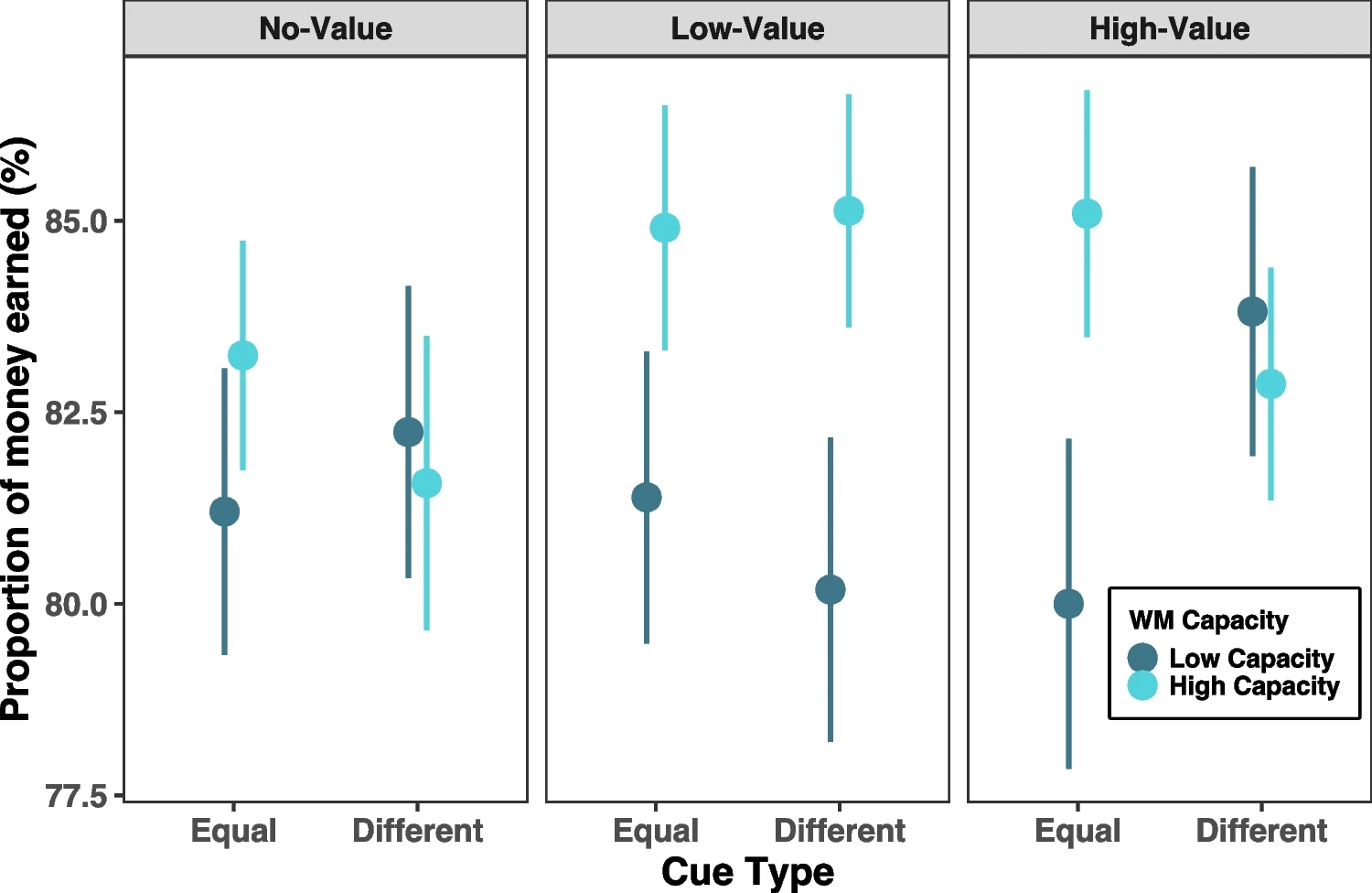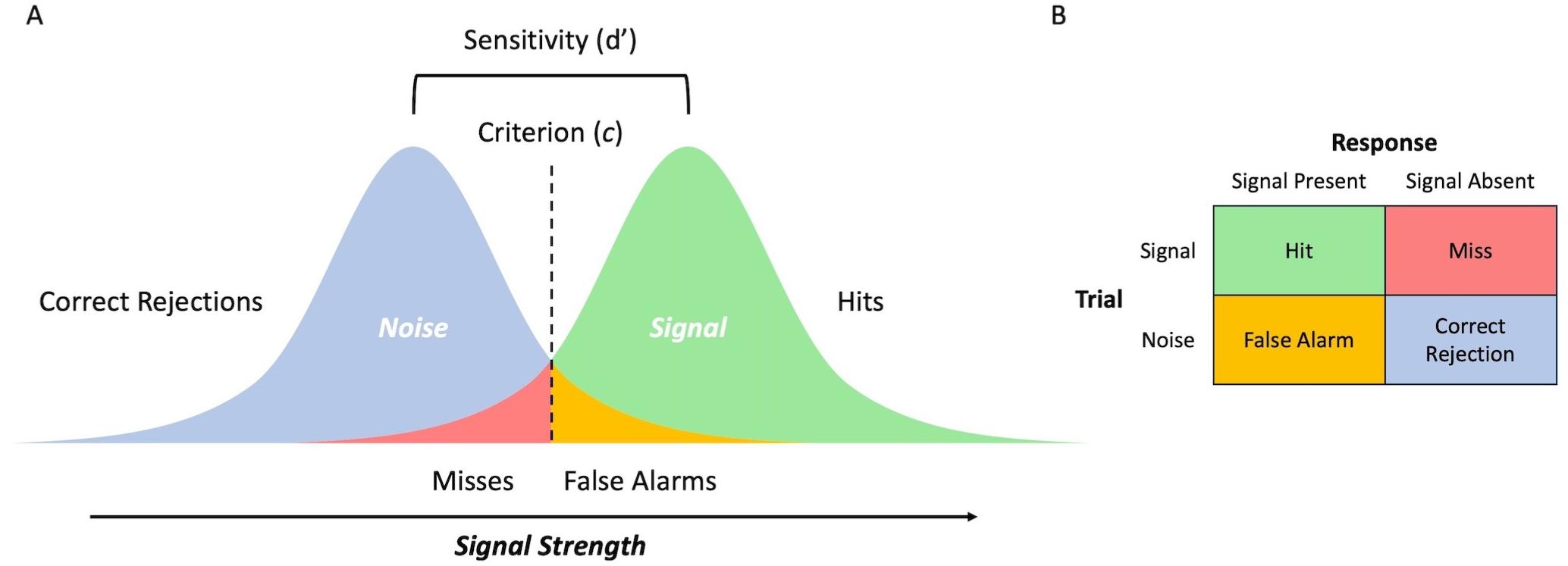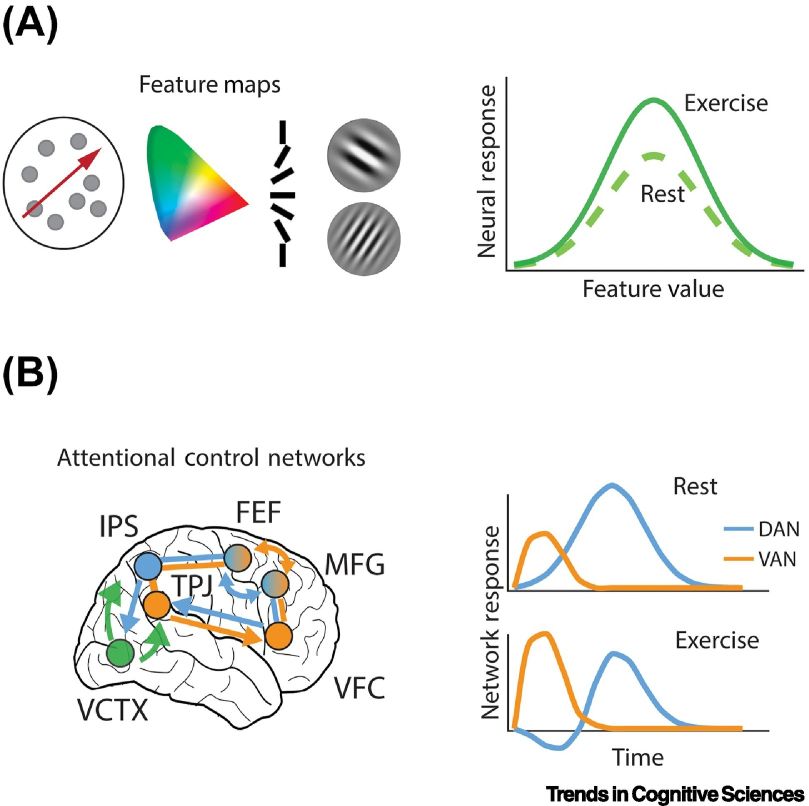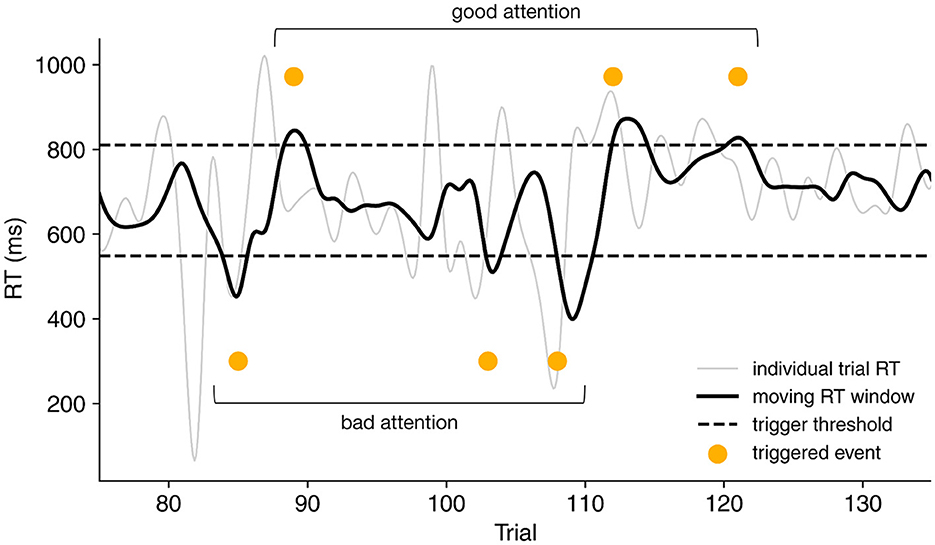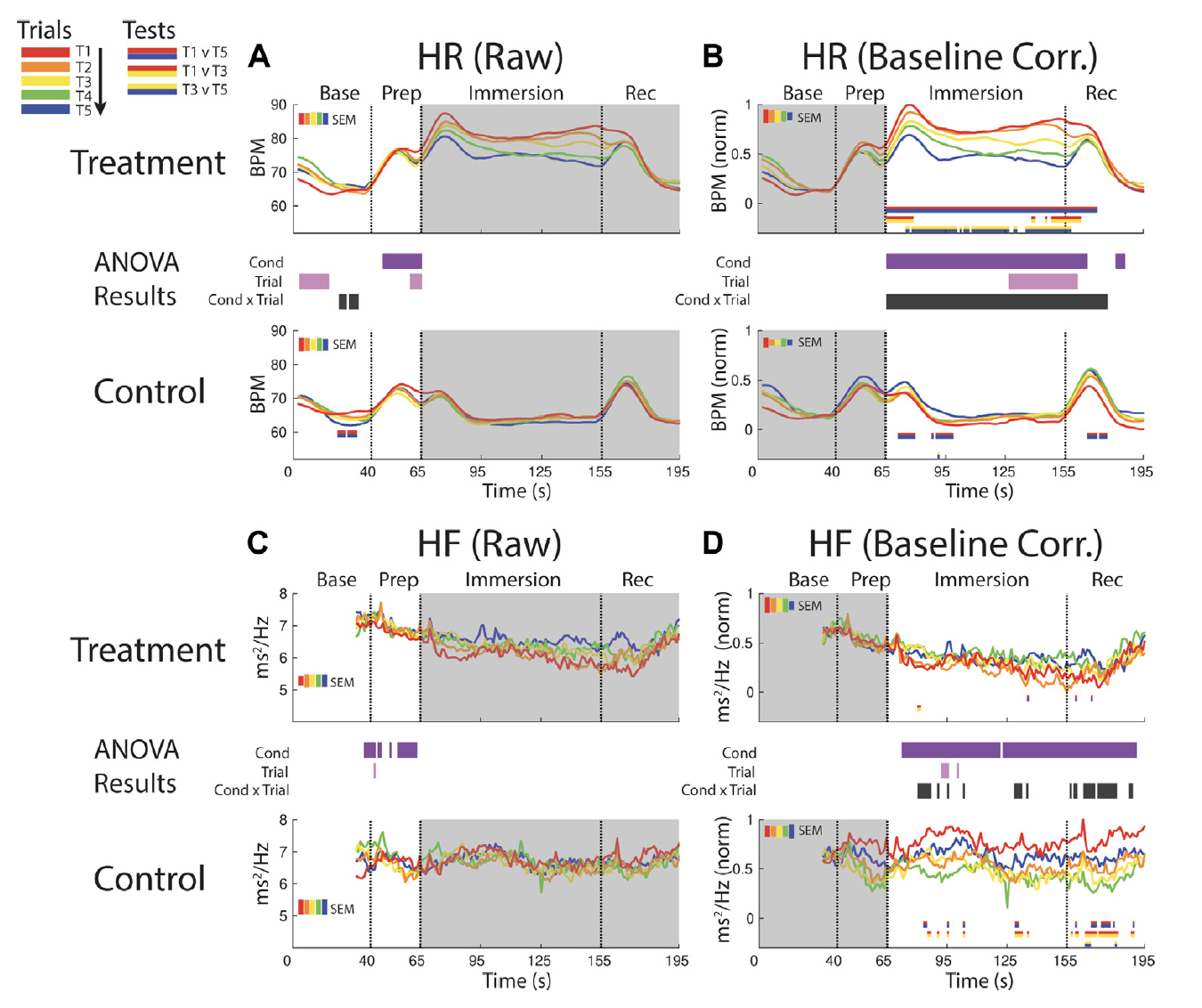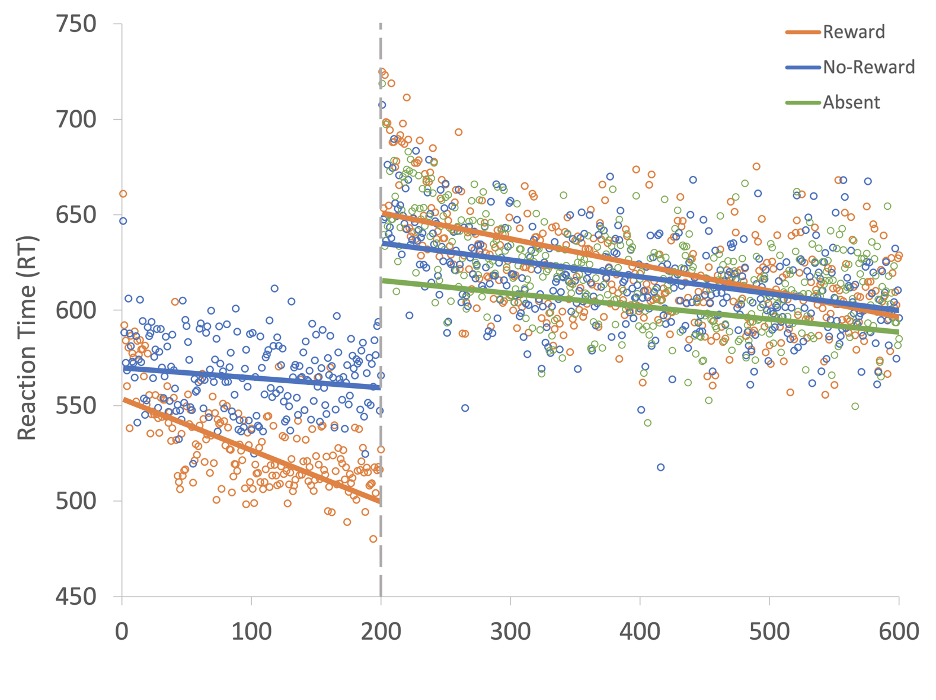Electronic versions are provided as a scientific courtesy. Copyright and all rights therein reside with the respective copyright holders, as stated within each paper. These files may not be reposted without permission.
Featured
Task‑irrelevant abrupt onsets differentially impact value‑related orienting and maintenance (Chak et al., 2025)
Physically salient stimuli are potent influences on behavior, but their negative impacts can be reduced in the presence of explicit goal-related cues. Here, we investigated whether goal-related cues associated with value are capable of insulating information from task-irrelevant abrupt onsets during two stages of information processing. Abrupt onsets were shown either after attention-directing cues and before a target (Experiment 1) or after a target that is to be remembered for later report (Experiment 2). The cues indicated the value associated with upcoming target locations, and they were either different in value, indicating that one was more valuable than the other, or equal in value. In both experiments, subjects were instructed to report the target that would earn them the most points (Experiment 1) or money (Experiment 2). In Experiment 1, performance suffered with equal cues, suggesting that orienting to multiple locations increases susceptibility to distraction from physically salient stimuli. In Experiment 2, the same pattern did not appear for abrupt onsets during the retention period; instead, the impact of the physically salient stimulus was dependent upon working memory capacity. The differential impact of abrupt onsets prior to (Experiment 1) and after (Experiment 2) encoding of value-related target locations suggest that physically salient task-irrelevant stimuli influence value-related information processing differently during orienting and maintenance.
Beyond Detection Rate: Understanding the Vigilance Decrement Using Signal Detection Theory (Skinner & Giesbrecht, 2025)
The vigilance decrement has been classically characterized as the decline in performance across time as individuals continuously attend to a task. Errors during these periods of degraded performance are often collectively characterized as failures of attention. Theoretically, using a single construct, such as attention, to describe impaired performance obscures what is likely a range of behaviors. Methodologically, the classic characterization of the vigilance decrement relies upon declines in detection rate, a binary measure that is unable to characterize performance beyond a single dimension. This is a critical issue for the study of vigilance because detection rate can be impacted both by changes in sensitivity and response criterion. Commonly used tasks do not allow for the reliable computation of these metrics because they elicit a low number of false alarms or because they introduce confounding response demands. To address these shortcomings, we propose the use of a paradigm amenable to the application of the signal detection framework, which permits the reliable and isolated investigation of the vigilance decrement across multiple measures.
Physically activated modes of attentional control (Giesbrecht et al., 2025)
As we navigate through the day, our attentional control processes are constantly challenged by changing sensory information, goals, expectations, and motivations. At the same time, our bodies and brains are impacted by changes in global physiological state that can influence attentional processes. Based on converging lines of evidence from brain recordings in physically active humans and nonhumans, we propose a new framework incorporating at least two physically activated modes of attentional control in humans: altered gain control and differential neuromodulation of control networks. We discuss the implications of this framework for understanding a broader range of states and cognitive functions studied both in the laboratory and in the wild.
Predicting attentional lapses using response time speed in continuous performance tasks (Shelat et al., 2024)
Failures of sustained attention, including lapses and mind-wandering, have serious consequences on cognitive task performance. In recent years, real-time triggering methods have been used to isolate periods of optimal and suboptimal attention based on patterns of response times in monotonous continuous performance tasks. In a closed-loop fashion, these triggering designs reduce the need for retrospective processing to identify periods of poor attention by using simple intrasubject response time boundaries to trigger events based on inferred attentional state. In the current review, we first discuss studies that used principal component analysis to identify response patterns that precede both task errors and phenomenological reports of mind-wandering. Then, we review designs that used real-time triggering conditions to reinforce the relationship between lapsing and memory encoding. Finally, we describe important next steps to generalize the utility of the triggering procedure across populations, validate lapse countermeasures, and shine light on the limited human capacity to maintain vigilance.
Non-invasive monitoring of cardiac contractility: Trans-radial electrical bioimpedance velocimetry (TREV) (Stump et al., 2023)
We describe methods and software resources for a bioimpedance measurement technique, ‘trans-radial electrical bioimpedance velocimetry’ (TREV) that allows for the non-invasive monitoring of relative cardiac contractility and stroke volume. After reviewing the relationship between the measurement and cardiac contractility, we describe the general recording methodology, which requires impedance measurements of the forearm. We provide open-source Jupyter-based software (operable on most computers) for deriving cardiac contractility from the impedance measurements. The software includes tools for removing variance associated with heart rate and respiration. We demonstrate the ability of this bioimpedance measurement for tracking beat-to-beat changes of contractility in a maximal grip force production task.
Habituation of the stress response multiplex to repeated cold pressor exposure (Bullock et al., 2023)
Humans show remarkable habituation to aversive events as reflected by changes of both subjective report and objective measures of stress. Although much experimental human research focuses on the effects of stress, relatively little is known about the cascade of physiological and neural responses that contribute to stress habituation. The cold pressor test (CPT) is a common method for inducing acute stress in human participants in the laboratory; however, there are gaps in our understanding of the global state changes resulting from this stress-induction technique and how these responses change over multiple exposures. Here, we measure the stress response to repeated CPT exposures using an extensive suite of physiologic measures and state-of-the-art analysis techniques.
The persistence of value-driven attention capture is task-dependent (Milner, MacLean, & Giesbrecht, 2023)
Visual features previously associated with reward can capture attention even when task- irrelevant, a phenomenon known as value-driven attention capture (VDAC). VDAC persists without reinforcement, unlike other forms of learning, where removing reinforcement typically leads to extinction. In five experiments, factors common to many studies were manipulated to examine their impact on VDAC and its extinction. All experiments included learning and test phases. During learning, participants completed a visual search task during which one of two target colors was associated with a reward, and the other with no reward. During test, one week later, participants completed another visual search task in which the reward association was not reinforced.
All Publications
Setu, J. N., Le, J. M., Kundu, R. K., Giesbrecht, B., Hollerer, T., Hoque, K. A., Desai, K., & Quarles, J. (2025). Predicting and Explaining Cognitive Load, Attention, and Working Memory in Virtual Multitasking. IEEE transactions on visualization and computer graphics. [pdf].
Chak, C., Machniak, E., & Giesbrecht, B. (2025). Task-irrelevant abrupt onsets differentially impact value-related orienting and maintenance. Attention, Perception, & Psychophysics. [pdf]
Bullock, T., Machniak, E., Passananti, J., Yu, K., Kumaran, R., Kim, Y.-J., Garrett, J., Viswesvaran, M., Ram, J., Höllerer, T., & Giesbrecht, B. (2025). Electrophysiological evidence for differential semantic processing of words and objects presented in augmented reality. Computers in Human Behavior Reports, 18, 100677. [pdf]
Shelat, S., & Giesbrecht, B. (2025). Perceptual decoupling in the sustained attention to response task is likely: comment on Bedi, Russell, & Helton (2024). Experimental brain research, 243(4), 86. [pdf]
Giesbrecht, B., Bullock, T., & Garrett, J. (2025). Physically activated modes of attentional control. Trends in Cognitive Sciences, 29(3), 295–307. [pdf]
Skinner, H. E., & Giesbrecht, B. (2025). Beyond detection rate: Understanding the vigilance decrement using signal detection theory. Frontiers in Cognition, 3, 1505046. [pdf]
Dundon, N. M., Stuber, A., Bullock, T., Garcia, J. O., Babenko, V., Rizor, E., Yang, D., Giesbrecht, B., & Grafton, S. T. (2024). Cardiac-sympathetic contractility and neural alpha-band power: Cross-modal collaboration during approach-avoidance conflict. Journal of Neuroscience. [pdf]
Garrett, J., Chak, C., Bullock, T., & Giesbrecht, B. (2024). A systematic review and Bayesian meta-analysis provide evidence for an effect of acute physical activity on cognition in young adults. Communications Psychology, 2(1). [pdf]
Shelat, S., Schooler, J. W., & Giesbrecht, B. (2024). Predicting attentional lapses using response time speed in continuous performance tasks. Frontiers in Cognition, 3. [pdf]
Santander, T., Leslie, S., Li, L. J., Skinner, H. E., Simonson, J. M., Sweeney, P., Deen, K. P., Miller, M. B., & Brunye, T. T. (2024). Towards optimized methodological parameters for maximizing the behavioral effects of transcranial direct current stimulation. Frontiers in Human Neuroscience, 18. [pdf]
Varshney, A., Munns, M. E., Kasowski, J., Zhou, M., He, C., Grafton, S. T., Giesbrecht, B., Hegarty, M., & Beyeler, M. (2024). Stress affects navigation strategies in immersive virtual reality. Scientific Reports, 14(1), 5949. [pdf]
Giesbrecht, B. & Garrett, J. (2024). Electroencephalography. In Encyclopedia of the Human Brain 2nd Edition. [pdf]
Boone, A. P., Bullock, T., MacLean, M. H., Santander, T., Raymer J., Stuber A., Jimmons L., Okafor G. N., Grafton, S. T., Miller, M. B., Giesbrecht, B., & Hegarty, M. (2024). Resilience of navigation strategy and efficiency to the impact of acute stress. Spatial Cognition & Computation, 24(1)1-32. [pdf]
Stump, A., Gregory, C., Babenko, V., Rizor, E., Bullock, T., Macy, A., Giesbrecht, B., Grafton, S. T., & Dundon, N. M. (2023). Non-invasive monitoring of cardiac contractility: Trans-radial electrical bioimpedance velocimetry (TREV). Psychophysiology, e14411. [pdf]
Bullock, T., Pickett, K., Salimian, A., Gregory, C., MacLean, M. H., & Giesbrecht, B. (2023). Eye movements disrupt EEG alpha-band coding of behaviorally relevant and irrelevant spatial locations held in working memory. Journal of Neurophysiology, 129, 1191-1211. [pdf]
Nakuci J, Wasylyshyn N, Cieslak M, Elliott JC, Bansal K, Giesbrecht B, Grafton ST, Vettel JM, Garcia JO, Muldoon SF. (2023). Within-subject reproducibility varies in multi-modal, longitudinal brain networks. Scientific Reports, 13: 6699. [pdf]
Thayer, D. D., Miller, M., Giesbrecht, B., & Sprague, T. C. (2023). Learned feature regularities enable suppression of spatially overlapping stimuli. Attention, Perception, & Psychophysics, 85, 767-784. [pdf]
Milner, A. E., MacLean, M. H., & Giesbrecht, B. (2023). The persistence of value-driven attention capture is task-dependent. Attention, perception & psychophysics, 85(2), 315–341. [pdf]
Kumaran, R., Kim, Y. J., Milner, A., Bullock, T., Giesbrecht, B., & Höllerer, T. The impact of navigation aids on search performance and object recall in wide-area augmented reality. Proceedings of the 2023 CHI Conference on Human Factors in Computing Systems, Article 710, pp. 1-17. [pdf]
Bullock, T., MacLean, M. H., Santander, T., Boone, A. P., Babenko, V., Dundon, N. M., Stuber, A., Jimmons, L., Raymer, J., Okafor, G. N., Miller, M. B., Giesbrecht, B., & Grafton, S. T. (2023). Habituation of the stress response multiplex to repeated cold pressor exposure. Frontiers in physiology, 13, 752900. [pdf]
Kim, Y. J., Kumaran, R., Sayyad, E., Milner, A., Bullock, T., Giesbrecht, B., & Höllerer, T. (2022). Investigating Search Among Physical and Virtual Objects Under Different Lighting Conditions. IEEE Transactions on Visualization and Computer Graphics, 28(11), 3788-3798. [pdf]
Thayer, D. D., Miller, M., Giesbrecht, B., & Sprague, T. C. (2022). Learned feature regularities enable suppression of spatially overlapping stimuli. Attention, Perception, & Psychophysics, 1-16. [pdf]
Bullock, T., Giesbrecht, B., Beaudin, A. E., Goodyear, B. G., & Poulin, M. J. (2021). Effects of changes in end-tidal PO2 and PCO2 on neural responses during rest and sustained attention. Physiological Reports, 9(21). doi:10.14814/phy2.15106. [pdf]
Garrett, J., Bullock, T., & Giesbrecht, B. (2021). Tracking the Contents of Spatial Working Memory during an Acute Bout of Aerobic Exercise. Journal of Cognitive Neuroscience, 33(7), 1271-1286. doi:10.1162/jocn_a_01714. [pdf]
Meghdadi, A. H., Giesbrecht, B., & Eckstein, M. P. (2021). EEG signatures of contextual influences on visual search with real scenes. Experimental Brain Research, 239(3), 797-809. doi:10.1101/2020.10.08.332247. [pdf]
Teich, E. G., Cieslak, M., Giesbrecht, B., Vettel, J. M., Grafton, S. T., Satterthwaite, T. D., & Bassett, D. S. (2021). Crystallinity characterization of white matter in the human brain. New Journal of Physics, 23(7), 073047. doi:10.1088/1367-2630/ac1286. [pdf]
Welbourne, L. E., Jonnalagadda, A., Giesbrecht, B., & Eckstein, M. P. (2021). The transverse occipital sulcus and intraparietal sulcus show neural selectivity to object-scene size relationships. Communications Biology, 4(1), 1-14. doi:10.1038/s42003-021-02294-9. [pdf]
Cieslak, M., Cook, P. A., He, X., et al. (2021). QSIPrep: an integrative platform for preprocessing and reconstructing diffusion MRI data. Nature methods, 18(7), 775-778. doi:10.1038/s41592-021-01185-5. [pdf]
Kumar, S., Iftekhar, A. S. M., Goebel, et al. (2021). StressNet: detecting stress in thermal videos. In Proceedings of the IEEE/CVF Winter Conference on Applications of Computer Vision (pp. 999-1009). [pdf]
Gobel, M. S., & Giesbrecht, B. (2020). Social information rapidly prioritizes overt but not covert attention in a joint spatial cueing task. Acta Psychologica, 211, 103188. [pdf]
Lauharatanahirun, N., Bansal, K., Thurman, S. M., Vettel, J. M., Giesbrecht, B., Grafton, S., ... & Garcia, J. O. (2020). Flexibility of brain regions during working memory curtails cognitive consequences to lack of sleep. arXiv preprint: 2009.07233. [pdf]
MacLean, M. H., Bullock, T. W., & Giesbrecht, B. (2019) Dual-process coding of recalled locations in human oscillatory brain activity. Journal of Neuroscience, 39, 6737-6750. [pdf]
Pun, M, Guadagni, V., Drogos, L. L., Pon, C., Hartmann, S. E., Furian, M., Lichtblau, M., Muralt, L., Bader, P. R., Moraga, F. A., Soza, D., Lopez, I., Rawling, J. W., Ulrich, S., Bloch, K.E., Giesbrecht, B., Poulin, M. J. (2019). Cognitive effects of repeated acute exposure to very high-altitude among altitude-experienced workers at 5050m. High Altitude Medicine & Biology. [pdf]
Pun, M, Guadagni, V., Bettauer, K. M., Drogos, L. L., Aitken, J., Hartmann, S. E., Furian, M., Muralt, L., Lichtblau, M., Bader, P. R., Rawling, J. W., Protzner, A. B., Ulrich, S., Bloch, K.E., Giesbrecht, B., Poulin, M. J. (2018). Effects on cognitive functioning of acute, subacute, and repeated exposures to high altitude. Frontiers in Physiology, 9:1131. [pdf]
Thurman, S. M., Wasylyshun, N., Roy, H., Lieberman, G., Garcia, J. O., Asturias, A., Okafor, G. N., Elliott, J. C., Giesbrecht, B., Grafton. S. T., Mednick, S. C., Vettel, J. M. 2018. Individual differences in compliance and agreement for sleep logs and wrist actigraphy: A longitudinal study of naturalistic sleep in healthy adults. PLoS One, 13(1): e0191883. [pdf]
Bullock, T. W., Elliott, J. C., Serences, J. T., & Giesbrecht, B. (2017). Acute exercise modulates feature-selective responses in human cortex. Journal of Cognitive Neuroscience, 29, 605-618. [pdf]
Elliott, J. C., Baird, B., & Giesbrecht, B. (2016). Consciousness isn’t all-or-none: Evidence for partial awareness during the attentional blink. Consciousness & Cognition, 40, 79-85. [pdf].
MacLean, M. H., Diaz, G. K., & Giesbrecht, B. (2016). Irrelevant learned reward associations disrupt voluntary spatial attention. Attention, Perception, & Psychophysics, 78, 2241-2252. [pdf]
Bullock, T. W., Cecotti, H., & Giesbrecht, B. (2015). Multiple stages of information processing are modulated during acute bouts of exercise. Neuroscience, 307, 138-150. [pdf]
Elliott, J. C. & Giesbrecht, B. (2015). Distractor suppression when attention fails: Behavioral evidence for a flexible selective attention mechanism. PLoS One, 10(4), e126203. [pdf]
Kasper, R. W., Grafton, S. T., Eckstein, M. P., & Giesbrecht, B. (2015). Multimodal neuroimaging evidence linking memory and attention systems during visual search cued by context. Annals of the New York Academy of Sciences. [pdf]
MacLean, M. H. & Giesbrecht, B. (2015). Neural evidence reveals the rapid effects of reward history on selective attention.Brain Research, 1606, 86-94. [pdf]
MacLean, M. H. & Giesbrecht, B. (2015). Irrelevant reward and selection histories have different influences on task relevant attentional selection. Attention, Perception, & Psychophysics, 77, 1515-1528. [pdf]
Bullock, T. W. & Giesbrecht, B. (2014). Acute exercise and aerobic fitness influence selective attention during visual search. Frontiers in Psychology, 5: 1290. [pdf]
Cecotti, H., Eckstein, M. P., Giesbrecht, B. (2014). Single-trial classification of event-related potentials in rapid serial visual presentation tasks using supervised spatial filtering. IEEE Neural Networks and Learning Systems, 25, 2030-2042. [pdf]
Sy, J. L., Guerin, S. A., Stegman, A., & Giesbrecht, B. (2014). Accurate expectancies diminish perceptual distraction during visual search. Frontiers in Human Neuroscience, 8: 334. [pdf]
Giesbrecht, B., Sy, J. L., Bundesen, C., & Kyllingsbæk, S. (2014). A new perspective on the perceptual selectivity of attention under load. Annals of the New York Academy of Sciences, 1316, 71-86. [pdf]
Elliott, J. C., Wallace, B. A., & Giesbrecht, B. (2014). A week-long meditation retreat decouples behavioral measures of the alerting and executive attention networks. Frontiers in Human Neuroscience, 8, 69 (9 pages). doi: 10.3389/fnhum.2014.00069. [pdf]
Kasper, R. W., Cecotti, H., Touryan, J., Eckstein, M. P., & Giesbrecht, B. (2014). Isolating the neural mechanisms of interference during continuous multisensory dual-task performance. Journal of Cognitive Neuroscience, 26, 476-489. Epub 2013 Sep 18. [pdf]
Sy, J. L., Elliott, J. C., & Giesbrecht, B. (2013). Post-perceptual processing during the attentional blink is modulated by inter-trial task expectancies. Frontiers in Human Neuroscience, 7, 627, doi: 10.3389/fnhum.2013.00627. [pdf]
Brown, K. S., Kasper, R. W., Giesbrecht, B., Carlson, J. M., & Grafton, S. T. (2013). Reproducible paired sources from concurrent EEG-fMRI data using BICAR. Journal of Neuroscience Methods, 219, 205-219. [pdf]
Preston, T., Guo, F., Das, K., Giesbrecht, B., & Eckstein, M. P. (2013). Neural representations of contextual guidance in visual search of real-world scenes. Journal of Neuroscience, 33, 7846-7855. [pdf]
Giesbrecht, B., Sy, J. L., & Guerin, S. A. (2012). Both memory and attention systems contribute to visual search for targets cued by implicit context. Vision Research, http://dx.doi.org/10.1016/j.visres.2012.10.006. [pdf]
Guo, F., Preston, T., Das, K. Giesbrecht, B., Eckstein, M. P. (2012). Feature-independent neural coding of target detection during search of natural scenes. Journal of Neuroscience, 32, 9499-9510. doi: 10.1523/JNEUROSCI.5876-11.2012. [pdf]
Kasper, R. W., Elliott, J. C., & Giesbrecht, B. (2012). Multiple measures of visual attention predict novice motor skill performance when attention is focused externally. Human Movement Science, http://dx.doi.org/10.1016/j.humov.2011.11.005. [pdf]
Eckstein, M. P., Das, K., Pham, B. T., Peterson, M. F., Abbey, C. K., Sy, J. L., & Giesbrecht, B. (2012). Neural decoding of collective wisdom with multi-brain computing. NeuroImage, 59, 94-108. [pdf]
Ristic, J. & Giesbrecht, B. (2011). Electrophysiological evidence for spatiotemporal flexibility in the ventrolateral attention network. PLoS One, 6, e24436. [pdf]
Kyllingsbaek, S, Sy, J. L., Giesbrecht, B. (2011). Understanding the allocation of attention when faced with varying perceptual load in partial report: A computational approach. Neuropsychologia, 49, 1487-1497. [pdf]
Smallwood, J., Brown, K. S., Tipper, C. M., Giesbrecht, B., Franklin, M. S., Mrazek, M. D., Carlson, J. M., & Schooler, J. W. (2011). Pupillometric evidence for the decoupling of attention from perceptual input during offline thought. PLoS One, 6, e18298. [pdf]
Peterson, M. F., Das, K., Sy, J. L., Li, S., Giesbrecht, B., Kourtzi, Z., Eckstein, M. P. (2010). Ideal observer analysis for task normalization of pattern classifier performance applied to EEG and fMRI data. Journal of the Optical Society of America A, 27, 2670-2683. [pdf]
Elliott, J. C. & Giesbrecht, B. (2010). Perceptual load modulates the processing of distractors presented at task-irrelevant locations during the attentional blink. Attention, Perception, & Psychophysics, 72, 2106-2114. [pdf]
Kasper, R., Das, K., Eckstein, M. P., Giesbrecht, B. (2010). Decoding information processing when attention fails: An electrophysiological approach. In T. Marek, W. Karwowski, & V. Rice (Eds), Advances in Understanding Human Performance: Neuroergonomics, Human Factors, and Special Populations. CRC Press/Taylor & Francis. [pdf]
Das, K., Li, S., Giesbrecht, B., Kourtzi, Z., Eckstein, M. P. (2010). Predicting perceptual performance from neural activity. In T. Marek, W. Karwowski, & V. Rice (Eds), Advances in Understanding Human Performance: Neuroergonomics, Human Factors, and Special Populations. CRC Press/Taylor & Francis. [pdf]
Das, K., Giesbrecht, B., & Eckstein, M. P. (2010). Predicting variations of perceptual performance across individuals from neural activity using pattern classifiers. NeuroImage, 51, 1425-1437. [pdf]
Sy, J. L. & Giesbrecht, B. (2009). Target-target similarity and the attentional blink: Task-relevance matters! Visual Cognition, 17, 307-317. [pdf]
Giesbrecht, B, Sy, J. L., & Lewis, M. K. (2009). Personal names do not always survive the attentional blink: Behavioral evidence for a flexible locus of selection. Vision Research, 49, 1378-1388. [pdf]
Das, K., Zhang, S., Giesbrecht, B., Eckstein, M. P. (2009). Using rapid visually evoked EEG activity for person identification. Conference Proceedings of the IEEE Engineering in Medicine and Biology Society, 1, 2490-2493. [pdf]
Gillath, O., Giesbrecht, B., & Shaver, P. R. (2009). Attachment, attention, and cognitive-control: Attachment style and performance on general attention tasks. Journal of Experimental Social Psychology, 45, 647-654. [pdf]
Kelley, T. A., Serences, J.T., Giesbrecht, B., & Yantis, S. (2008). Cortical mechanisms for shifting and holding visuospatial attention. Cerebral Cortex, 18, 114-125. [pdf]
Tipper, C. M., Handy, T. C., Giesbrecht, B., & Kingstone, A. (2008). Brain responses to biological relevance. Journal of Cognitive Neuroscience, 20, 879-891. [pdf]
Slagter, H. A., Giesbrecht, B., Kok, A., Weissman, D. H., Kenemans, J. L., Woldorff, M. G., & Mangun, G. R. (2007). fMRI evidence for both generalized and specialized components of attentional control. Brain Research, 1177, 90-102. [pdf]
Giesbrecht, B., Sy, J. L., & Elliott, J. C. (2007). Electrophysiological evidence for both perceptual and post-perceptual selection during the attentional blink. Journal of Cognitive Neuroscience, 19, 2005-2018. [pdf]
van Zoest, W., Giesbrecht, B., Enns, J. T., & Kingstone, A. (2006). New reflections on visual search: Inter-item symmetry matters! Psychological Science, 17, 535-542. [pdf]
Slagter, H. A., Weissman, D. H., Giesbrecht, B., Kenemans, J. L., Mangun, G. R., Kok, A., & Woldorff, M. G. (2006). Brain regions activated by endogenous preparatory set-shifting as revealed by fMRI. Cognitive, Affective, and Behavioral Neuroscience, 6, 175-189. [pdf]
Giesbrecht, B., Weissman, D. H., Woldorff, M. G., & Mangun (2006). Pre-target activity in visual cortex predicts behavioral performance on spatial and feature attention tasks. Brain Research, 1080, 63-72. [pdf]
Giesbrecht, B., Kingstone, A., Handy, T. C., Hopfinger, J. B., & Mangun, G. R. (2006). Functional neuroimaging of attention. In A. Kingstone & R. Cabeza (Eds.), Handbook on Functional Neuroimaging of Cognition. Cambridge, MA: MIT Press.
Giesbrecht, B. & Mangun, G. R. (2005). Identifying the neural systems of top-down attentional control: A meta-analytical approach. In L. Itti, G. Rees, & J. Tsotsos (Eds.), Neurobiology of Attention. New York: Academic Press/Elsevier. [pdf]
German, T. P., Niehaus, J. L., Roarty, M. P., Giesbrecht, B., & Miller, M. B. (2004). Neural correlates of detecting pretense: Automatic engagement of the intentional stance under covert conditions. Journal of Cognitive Neuroscience, 16, 1805-1817. [pdf]
Giesbrecht, B., Bischof, W. F., & Kingstone, A. (2004). Seeing the light: Adapting luminance reveals low-level visual processes in the attentional blink. Brain & Cognition, 55, 307-309. [pdf]
Giesbrecht, B., Bischof, W. F., & Kingstone, A. (2003). Visual masking during the attentional blink: Tests of the object substitution hypothesis. Journal of Experimental Psychology: Human Perception & Performance, 29, 238-258. [pdf]
Giesbrecht, B., Camblin, C. C., Swaab, T. Y. (2004). Separable effects of semantic priming and imageability on word processing in human cortex. Cerebral Cortex, 14, 521-529. [pdf]
Giesbrecht, B. & Di Lollo, V. (1998). Beyond the attentional blink: Visual masking by object substitution. Journal of Experimental Psychology: Human Perception and Performance, 24, 1454-1456. [pdf]
Giesbrecht, B., Dixon P., & Kingstone, A. (2001). Cued shifts of attention and memory encoding in partial report: A dual-task approach. Quarterly Journal of Experimental Psychology - Section A, 54, 695-725. [pdf]
Giesbrecht, B. & Dixon P. (1999). Isolating the interference caused by cue duration in partial report: A quantitative approach. Memory & Cognition, 27, 220-233. [pdf]
Giesbrecht, B., & Kingstone, A. (2004). Right hemisphere involvement in the attentional blink: Evidence from a split-brain patient. Brain & Cognition, 55, 303-306. [pdf]
Giesbrecht, B., & Mangun, G. R. (2002). The neural mechanisms of top-down control. In H.-O. Karnath, D. Milner, & G. Vallar (Eds.), The Cognitive and Neural Bases of Spatial Neglect. Oxford, UK: Oxford University Press.
Giesbrecht, B., Woldorff, M. G., Song, A. W., & Mangun, G. R. (2003). Neural mechanisms of top-down control during spatial and feature attention. NeuroImage, 19, 496-512. [pdf]
McFadden, S. M., Giesbrecht, B. L., & Gula, C. (1998). Use of an automatic tracker as a function of its reliability. Ergonomics, 41, 512-536. [pdf]
Weissman, D. H., Giesbrecht, B., Song. A. W., Mangun, G. R., & Woldorff, M. G. (2003). Conflict monitoring in the human anterior cingulate cortex during selective attention to global and local object features. NeuroImage, 19, 1361-1368. [pdf]
